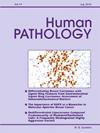Artificial intelligence in breast pathology: Overview and recent updates
IF 2.6
2区 医学
Q2 PATHOLOGY
引用次数: 0
Abstract
Breast cancer remains a major global health concern where timely and accurate pathologic diagnosis is critical for effective management. The traditional reliance on expert interpretation of histopathology is increasingly challenged by rising workloads, inter-observer variability, and the complexity of current precision pathology. The advent of digital pathology through whole slide imaging (WSI) has enabled the integration of artificial intelligence (AI) into breast pathology practice, offering promising solutions to these challenges.
This review explores the major advancements of AI in breast pathology, including its applications in diagnosis and classification, histological grading, lymph node metastasis detection, and biomarker quantification (ER, PR, HER2, Ki-67, and others). We also discuss AI's emerging roles in prognosis, treatment response, tumor microenvironment analysis, and the discovery of novel biomarkers. Despite the significant progress, barriers such as data quality, generalizability, model interpretability, regulatory challenges, and integration into clinical workflows remain. Future directions emphasize the development of foundation models, multimodal data integration, explainable AI, real-world clinical validation, and decentralized learning approaches. With careful navigation of these challenges and continued interdisciplinary collaboration, AI is poised to transform breast pathology and advance patient care.
乳腺病理学中的人工智能:综述和最新进展。
乳腺癌仍然是一个主要的全球健康问题,及时和准确的病理诊断是有效管理的关键。由于工作量的增加、观察者之间的差异以及当前精确病理的复杂性,对组织病理学专家解释的传统依赖日益受到挑战。通过全幻灯片成像(WSI)实现数字病理学的出现,使人工智能(AI)能够整合到乳房病理学实践中,为这些挑战提供了有希望的解决方案。本文综述了人工智能在乳腺病理学中的主要进展,包括其在诊断和分类、组织学分级、淋巴结转移检测和生物标志物定量(ER、PR、HER2、Ki-67等)方面的应用。我们还讨论了人工智能在预后、治疗反应、肿瘤微环境分析和新生物标志物发现方面的新兴作用。尽管取得了重大进展,但数据质量、通用性、模型可解释性、监管挑战以及与临床工作流程的整合等障碍仍然存在。未来的方向强调基础模型、多模态数据集成、可解释的人工智能、现实世界的临床验证和分散学习方法的发展。通过对这些挑战的仔细导航和持续的跨学科合作,人工智能有望改变乳房病理学并推进患者护理。
本文章由计算机程序翻译,如有差异,请以英文原文为准。
求助全文
约1分钟内获得全文
求助全文
来源期刊

Human pathology
医学-病理学
CiteScore
5.30
自引率
6.10%
发文量
206
审稿时长
21 days
期刊介绍:
Human Pathology is designed to bring information of clinicopathologic significance to human disease to the laboratory and clinical physician. It presents information drawn from morphologic and clinical laboratory studies with direct relevance to the understanding of human diseases. Papers published concern morphologic and clinicopathologic observations, reviews of diseases, analyses of problems in pathology, significant collections of case material and advances in concepts or techniques of value in the analysis and diagnosis of disease. Theoretical and experimental pathology and molecular biology pertinent to human disease are included. This critical journal is well illustrated with exceptional reproductions of photomicrographs and microscopic anatomy.
 求助内容:
求助内容: 应助结果提醒方式:
应助结果提醒方式:


